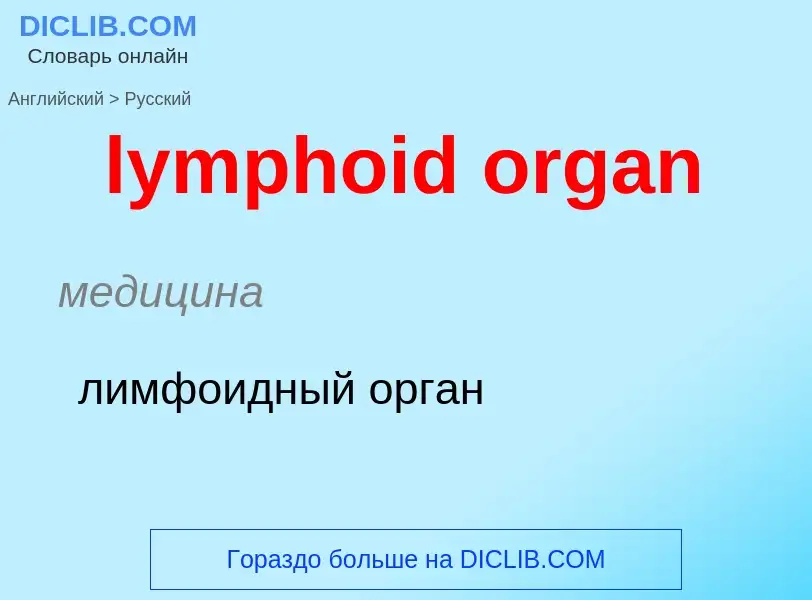Translation and analysis of words by ChatGPT artificial intelligence
On this page you can get a detailed analysis of a word or phrase, produced by the best artificial intelligence technology to date:
- how the word is used
- frequency of use
- it is used more often in oral or written speech
- word translation options
- usage examples (several phrases with translation)
- etymology
lymphoid organ - translation to russian
медицина
лимфоидный орган
медицина
лимфоидный вторичный орган
общая лексика
центральный лимфоидный орган
Definition
Wikipedia

The lymphatic system, or lymphoid system, is an organ system in vertebrates that is part of the immune system, and complementary to the circulatory system. It consists of a large network of lymphatic vessels, lymph nodes, lymphoid organs, lymphoid tissues and lymph. Lymph is a clear fluid carried by the lymphatic vessels back to the heart for re-circulation. (The Latin word for lymph – lympha refers to the deity of fresh water, "Lympha")
Unlike the circulatory system that is a closed system, the lymphatic system is open. The human circulatory system processes an average of 20 litres of blood per day through capillary filtration, which removes plasma from the blood. Roughly 17 litres of the filtered blood is reabsorbed directly into the blood vessels, while the remaining three litres are left in the interstitial fluid. One of the main functions of the lymphatic system is to provide an accessory return route to the blood for the surplus three litres.
The other main function is that of immune defense. Lymph is very similar to blood plasma, in that it contains waste products and cellular debris, together with bacteria and proteins. The cells of the lymph are mostly lymphocytes. Associated lymphoid organs are composed of lymphoid tissue, and are the sites either of lymphocyte production or of lymphocyte activation. These include the lymph nodes (where the highest lymphocyte concentration is found), the spleen, the thymus, and the tonsils. Lymphocytes are initially generated in the bone marrow. The lymphoid organs also contain other types of cells such as stromal cells for support. Lymphoid tissue is also associated with mucosas such as mucosa-associated lymphoid tissue (MALT).
Fluid from circulating blood leaks into the tissues of the body by capillary action, carrying nutrients to the cells. The fluid bathes the tissues as interstitial fluid, collecting waste products, bacteria, and damaged cells, and then drains as lymph into the lymphatic capillaries and lymphatic vessels. These vessels carry the lymph throughout the body, passing through numerous lymph nodes which filter out unwanted materials such as bacteria and damaged cells. Lymph then passes into much larger lymph vessels known as lymph ducts. The right lymphatic duct drains the right side of the region and the much larger left lymphatic duct, known as the thoracic duct, drains the left side of the body. The ducts empty into the subclavian veins to return to the blood circulation. Lymph is moved through the system by muscle contractions. In some vertebrates, a lymph heart is present that pumps the lymph to the veins.
The lymphatic system was first described in the 17th century independently by Olaus Rudbeck and Thomas Bartholin.




![efferent]] [[lymphatic vessel]]s efferent]] [[lymphatic vessel]]s](https://commons.wikimedia.org/wiki/Special:FilePath/Illu lymph node structure.png?width=200)
![first-pass metabolism]] completely. first-pass metabolism]] completely.](https://commons.wikimedia.org/wiki/Special:FilePath/Nutrient absorbtion to blood and lymph.png?width=200)
!["Claude Galien"]]. Lithograph by Pierre Roche Vigneron. (Paris: Lith de Gregoire et Deneux, ca. 1865) "Claude Galien"]]. Lithograph by Pierre Roche Vigneron. (Paris: Lith de Gregoire et Deneux, ca. 1865)](https://commons.wikimedia.org/wiki/Special:FilePath/Galen detail.jpg?width=200)
![[[Gabriele Falloppio]] [[Gabriele Falloppio]]](https://commons.wikimedia.org/wiki/Special:FilePath/Gabriele_Falloppio.jpg?width=200)
![Eustachius]] Eustachius]]](https://commons.wikimedia.org/wiki/Special:FilePath/Bartolomeus Eustachius.jpg?width=200)
![[[Olaus Rudbeck]] in 1696. [[Olaus Rudbeck]] in 1696.](https://commons.wikimedia.org/wiki/Special:FilePath/Olaus Rudbeck Sr (portrait by Martin Mijtens Sr, 1696).jpg?width=200)
![[[Thomas Bartholin]] [[Thomas Bartholin]]](https://commons.wikimedia.org/wiki/Special:FilePath/Thomas bartholin.jpg?width=200)
